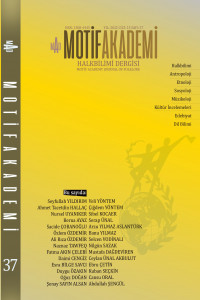ÇEŞİTLİ MÜZİK KÜLTÜRLERİNDE ÇAĞRI YANIT YÖNTEMİNİN KULLANILDIĞI İŞ ŞARKILARI
WORK SONGS USING CALL AND RESPONSE METHOD IN VARIOUS MUSIC CULTURES
Author(s): Mustafa DağdevirenSubject(s): Music, Cultural Anthropology / Ethnology, Culture and social structure , Methodology and research technology
Published by: Motif Halk Oyunları Eğitim ve Öğretim Vakfı
Keywords: Call-response; work songs; music culture; sailor songs; prison work songs;
Summary/Abstract: Call and response technique, which is a frequently used application in world music cultures, is used in the memorization of the lyrics in the perspective of music, keeping various melodies and rhythms in musical memory, teaching music, carrying many musical structures in the ethnology of belief music, master-apprentice in instrument teaching. It is an archaic method used in many fields in children's songs and dance music, within the meşk method, which is based on the relationship. In addition to these areas, it is the most used method in business songs, which is one of the areas where the functional dimension of music is used most frequently, with various applications such as overcoming the difficulties of doing business in many cultures around the world, working together on a certain rhythmic metronome, and providing motivation. This study focuses on sailors' songs from "Chanty" to "min-yo" in Japan, from hon ballads in Anatolia to "Haozi" in China, from prison work songs to military cadence music in the United States, from "Biguine" in the Caribbean to "trillera" in Flamenco, from Ovi's in India. This study was carried out in order to analyze the songs sung by the call-and-answer method in the work songs found in many cultural structures, from a cultural perspective, and to the "coro-pregón" in Latin dance music. In the study, cultural analyzes were carried out by using the qualitative method, technique and approach, and the descriptive scanning, e-field study and netrography pattern of this technique.
Journal: Motif Akademi Halkbilimi Dergisi
- Issue Year: 15/2022
- Issue No: 37
- Page Range: 291-308
- Page Count: 18
- Language: Turkish

